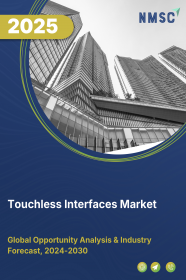
Touchless Interfaces Market by Product (Touchless Sanitary Equipment, Touchless Biometric, and Others), by Technology (Touch-Based Gesture Recognition, Touchless Gesture Recognition, RFID Technology, Camera-Based Technology, Sensors, Voice Assistance, and Others), and by End User (Automotive, Consumer Electronics, Healthcare, Advertisement & Communication, Defense, Finance and Banking, Government, and Others) - Global Opportunity Analysis and Industry Forecast 2023-2030
Market Definition
The global Touchless Interfaces Market size was valued at USD 10.74 billion in 2022 and is predicted to reach USD 54.71 billion by 2030 with a CAGR of 22.5% from 2023-2030. A touchless interface refers to a technology that enables interactions with devices or systems without the need for physical contact. It utilizes sensors, cameras, or other motion-detection mechanisms to detect and interpret users' gestures, motions, or voice commands, enabling seamless control and navigation.
Touchless interfaces have gained significant popularity in various industries, such as healthcare, retail, automotive, and consumer electronics, due to their hygienic nature and user-friendly experience. They are commonly found in touchless payment systems, gesture-controlled devices, voice-activated assistants, and contactless interactive displays. By eliminating the need for physical touch, touchless interfaces offer enhanced convenience, accessibility, and safety, making them increasingly prevalent in modern technological applications.
Market Dynamics and Trends
The booming consumer electronics industry drives the touchless interface market, with increasing demand for user-friendly touchless features in devices such as smartphones, tablets, smart speakers, and wearables. Touchless interactions, such as voice commands and gesture controls, provide convenience, and speed.
Also, the market is experiencing rapid growth due to the increasing adoption of IoT devices such as smart speakers, smart phones, smart home gadgets, and wearables, which come with touchless capabilities such as voice commands and gesture controls. For instance, in May 2023, OpenAI launched an iOS app for Apple devices with an in-app voice assistant. This voice assistant utilizes the powerful GPT-3.5 language model, enabling users to interact and receive responses in natural language.
Integrating the in-app voice assistant provides an enhanced user experience, allowing individuals to ask questions, seek information, and engage in conversations seamlessly within the app. With this innovative addition, OpenAI aims to revolutionize how people interact with their mobile devices and make accessing information and performing various tasks using voice commands easier and more intuitive than before.
In addition, the rising implementation of artificial intelligence (AI) and machine learning (ML) to create advanced touchless interfaces that can understand and respond to user commands is further expected to fuel the growth of the market. However, the high cost of development and implementing touchless technology along with privacy & security concerns, are the factors restraining the growth of the market during the forecast period. On the contrary, the increasing availability of advanced sensors and actuators that are used to create touchless interfaces are expected to create ample growth opportunities for the market in the coming years.
Market Segmentations and Scope of the Study
The touchless interfaces market report is segmented on the basis of product, technology, end user and geography. On the basis of product, the market is divided into touchless sanitary equipment, touchless biometric, and others. On the basis of technology, the market is classified into touch-based gesture recognition, touchless gesture recognition, RFID technology, camera-based technology, sensors, voice assistance, and others.
On the basis of end user, the market is categorized into automotive, consumer electronics, healthcare, advertisement & communication, defense, finance and banking, government, and others. Geographic breakdown and analysis of each of the aforesaid segments includes regions comprising of North America, Europe, Asia-Pacific, and RoW.
Geographical Analysis
North America holds the lion's share of the touchless interfaces market and is expected to continue its dominance during the forecast period. The increasing demand for enhanced security in areas due to significant tourism and stringent immigration rules is driving the growth of the global market. For instance, in September 2021, the U.S. Customs and Border Protection (CBP) announced the introduction of new features in its CBP ROAM application, aimed at expanding touchless service for boaters by making it easier for them to apply for and update cruising licenses.
Also, the presence of major key players such as Microsoft Corporation, Intel Corporation, Microchip Technology Inc., and Apple Inc. that are adopting product launches as their developmental strategy in turn accelerates the market growth in this region. For instance, in June 2022, Intel developed UCL MotionInput in collaboration with Microsoft and IBM, the software was built by students at the University College London’s (UCL) Computer Science department. By utilizing a webcam, UCL MotionInput empowers individuals to operate their computers without physical contact, using gestures from their head, hands, entire body, or speech for control.
On the other hand, Asia-Pacific is expected to show a steady rise in the touchless interfaces market due to integration of touchless interfaces in various applications within smart cities and buildings, such as elevators and gates, in this region. For instance, in September 2022, Hitachi Elevator Asia introduced a touchless operating panel for elevators, designed to ensure user safety and hygiene in smart houses. This technology enables passengers to control elevators using hand gestures, reducing the need for physical contact with surfaces.
Moreover, the rising collaboration of major tech giants for the development of highly advanced touchless interfaces is further driving the growth of the market in the region. For instance, in May 2023, numerous tech giants, including Asukanet, Mitsui Chemicals, Kanda Kogyo, and Toshiba Tec, have introduced a "world-first" touchless aerial cash register system in six 7-Eleven stores in Japan. The Touchless Aerial Display Point of Sale (PoS) Register projects interactive images in mid-air, enabling customers to interact with the display by pointing their fingers, offering a contactless solution for transactions and improving user experience.
Competitive Landscape
The touchless interfaces industry trends comprise of various market players such as Microsoft Corporation, Microchip Technology Inc., Apple Inc., Google LLC, Intel Corporation, TouchNetix, Qualcomm Technologies Inc., Infineon Technologies AG, Microchip Technology Inc. and Omnivision Technologies Inc. These market players are adopting product launches as their key developmental strategy across various regions to maintain their dominance in the global market.
For instance, in April 2022, TouchNetix launched Axiom touchscreen chip. This touchscreen integrates 3D sensing capability by recognizing air gestures, enabling touchless functions in various sectors such as automotive, industrial, and consumer products.
Moreover, in December 2021, Infineon Technologies AG launched its fifth-generation CAPSENSE touch sensing system. This sensing system combined capacitive and inductive touch sensing human-machine interface (HMI) technology. This new technology offered high performance and low power consumption suitable for a wide range of application such as home appliances, smart door locks, smart switches, thermostats, smart speakers, power tools, industrial touchscreens, and other IoT devices.
Key Benefits
-
The report provides quantitative analysis and estimations of the touchless interface market from 2023 to 2030, which assists in identifying the prevailing market opportunities.
-
The study comprises a deep-dive analysis of the touchless interface market including the current and future trends to depict prevalent investment pockets in the market.
-
Information related to key drivers, restraints, and opportunities and their impact on the touchless interface market is provided in the report.
-
Competitive analysis of the players, along with their market share is provided in the report.
-
SWOT analysis and Porters Five Forces model is elaborated in the study.
-
Value chain analysis in the market study provides a clear picture of roles of stakeholders.
Touchless Interface Market Key Segments
By Product
-
Touchless Sanitary Equipment
-
Touchless Biometric
-
Others
By Technology
-
Touch-Based Gesture Recognition
-
Touchless Gesture Recognition
-
RFID Technology
-
Camera-Based Technology
-
Sensors
-
Voice Assistance
-
Others
By End User
-
Automotive
-
Consumer Electronics
-
Healthcare
-
Advertisement & Communication
-
Defense
-
Finance and Banking
-
Government
-
Others
By Region
-
North America
-
The U.S.
-
Canada
-
Mexico
-
-
Europe
-
The UK
-
Germany
-
France
-
Italy
-
Spain
-
Denmark
-
Netherlands
-
Finland
-
Sweden
-
Norway
-
Russia
-
Rest of Europe
-
-
Asia-Pacific
-
China
-
Japan
-
India
-
South Korea
-
Australia
-
Indonesia
-
Singapore
-
Taiwan
-
Thailand
-
Rest of Asia-Pacific
-
-
RoW
-
Latin America
-
Middle East
-
Africa
-
Key Players
-
Microsoft Corporation
-
Microchip Technology Inc.
-
Apple Inc.
-
Google LLC
-
Intel Corporation
-
TouchNetix
-
Qualcomm Technologies Inc.
-
Infineon Technologies AG
-
Microchip Technology Inc.
-
Omnivision Technologies Inc
Report Scope and Segmentation
|
Parameters |
Details |
|
Market Size in 2022 |
USD 10.74 Billion |
|
Revenue Forecast in 2030 |
USD 54.71 Billion |
|
Growth Rate |
CAGR of 22.5% from 2023 to 2030 |
|
Analysis Period |
2022–2030 |
|
Base Year Considered |
2022 |
|
Forecast Period |
2023–2030 |
|
Market Size Estimation |
Billion (USD) |
|
Growth Factors |
The booming consumer electronics industry fuels the market growth. Increasing adoption of IoT devices such as smart speakers, smart phones and others drives the market growth Rising implementation of artificial intelligence (AI) and machine learning (ML) to create advanced touchless interfaces is driving the market. |
|
Countries Covered |
28 |
|
Companies Profiled |
10 |
|
Market Share |
Available for 10 companies |
|
Customization Scope |
Free customization (equivalent up to 80 working hours of analysts) after purchase. Addition or alteration to country, regional, and segment scope. |
|
Pricing and Purchase Options |
Avail customized purchase options to meet your exact research needs. |




















 Speak to Our Analyst
Speak to Our Analyst
























